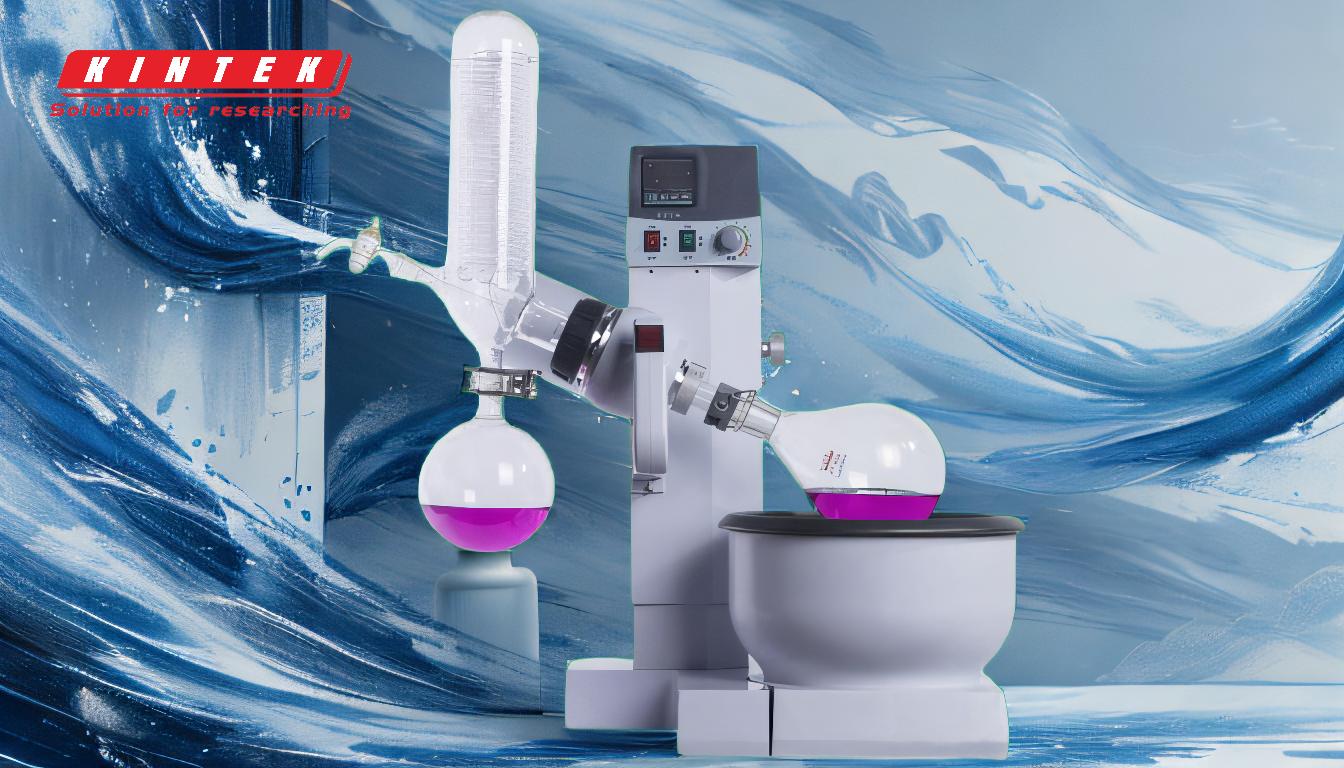The rotovap process, short for rotary evaporation, is a laboratory technique used to efficiently and gently remove solvents from a solution through evaporation under reduced pressure. The process involves placing the solution in a rotating flask, which is partially immersed in a heated water bath. A vacuum pump reduces the pressure inside the system, lowering the boiling point of the solvent and allowing it to evaporate at a lower temperature. The evaporated solvent is then condensed in a cooled condenser and collected in a receiving flask. This method is widely used in chemistry, pharmaceuticals, and food science to isolate and purify compounds while minimizing thermal degradation and oxidation.
Key Points Explained:

-
Setup and Preparation:
- Starting Flask: The solution to be evaporated is placed in a round-bottom flask, which is securely attached to the rotary evaporator.
- Water Bath: A heated water bath is prepared at a temperature appropriate for the solvent being evaporated. This ensures controlled and even heating of the solution.
- Vacuum System: A vacuum pump is connected to the system to reduce the internal pressure, which lowers the boiling point of the solvent.
- Condenser: A condenser, typically cooled with water or a refrigerant, is used to condense the evaporated solvent back into liquid form.
-
Rotation and Evaporation:
- Rotation Speed: The flask is rotated at a controlled speed, creating a thin film of the solution on the inner surface of the flask. This increases the surface area for evaporation and promotes uniform heating.
- Evaporation Under Vacuum: As the flask rotates and the solution is heated, the solvent begins to evaporate at a reduced pressure. The vacuum pump ensures that the pressure inside the system is lower than atmospheric pressure, facilitating evaporation at a lower temperature.
-
Condensation and Collection:
- Condenser Chamber: The evaporated solvent travels from the rotating flask to the condenser, where it is cooled and condensed back into a liquid.
- Receiving Flask: The condensed solvent is collected in a separate receiving flask, leaving behind the desired compound or residue in the original flask.
-
Advantages of the Rotovap Process:
- Gentle Evaporation: By operating under reduced pressure, the rotovap process allows for the evaporation of solvents at lower temperatures, reducing the risk of thermal degradation of sensitive compounds.
- Efficient Solvent Recovery: The process is highly efficient in recovering solvents, making it both cost-effective and environmentally friendly.
- Precision and Control: The ability to control temperature, pressure, and rotation speed allows for precise and reproducible results, which is crucial in research and industrial applications.
-
Operational Steps:
- Initial Setup: Ensure the water bath is heated to the desired temperature and the condenser is properly cooled. Empty the solvent trap if necessary.
- Securing the Flask: Attach the sample flask to the rotary evaporator, ensuring it is securely clamped and the bump trap is in place to prevent splashing.
- Starting the Process: Turn on the vacuum pump and adjust the pressure. Start the rotation of the flask at an appropriate speed.
- Monitoring and Adjustment: Gradually increase the vacuum and adjust the rotation speed as needed. Monitor the process for signs of condensation or bubbling.
- Completion: Once all the solvent has evaporated, stop the rotation and release the vacuum. Carefully remove the flask containing the residue.
-
Applications:
- Chemical Synthesis: Used to concentrate reaction mixtures and isolate products.
- Pharmaceuticals: Essential in the purification of active pharmaceutical ingredients (APIs).
- Food and Beverage Industry: Used to concentrate flavors, remove solvents from extracts, and produce essential oils.
- Environmental Analysis: Helps in the concentration of samples for trace analysis.
-
Safety Considerations:
- Vacuum Operation: Always ensure that the system is properly sealed to maintain the vacuum and prevent leaks.
- Temperature Control: Avoid overheating the solution, which could lead to decomposition or boiling over.
- Chemical Compatibility: Ensure that all components of the rotovap system are compatible with the solvents and chemicals being used.
In summary, the rotovap process is a versatile and efficient method for solvent removal and compound isolation, widely used across various scientific and industrial fields. Its ability to operate under reduced pressure and controlled conditions makes it an invaluable tool for researchers and professionals alike.
Summary Table:
| Aspect | Details |
|---|---|
| Process | Evaporation under reduced pressure using a rotating flask and vacuum system. |
| Key Components | Rotating flask, water bath, vacuum pump, condenser, and receiving flask. |
| Advantages | Gentle evaporation, efficient solvent recovery, precise control. |
| Applications | Chemical synthesis, pharmaceuticals, food science, environmental analysis. |
| Safety Considerations | Proper sealing, temperature control, and chemical compatibility. |
Discover how the rotovap process can enhance your lab's efficiency—contact us today for expert advice!












